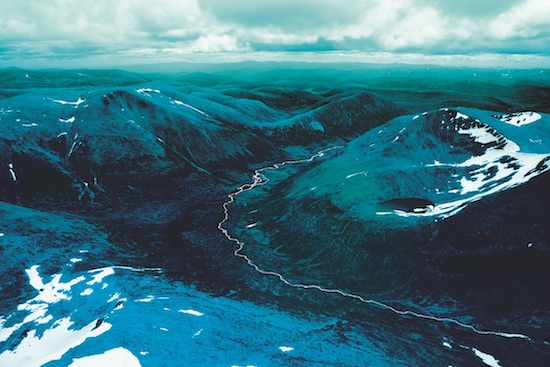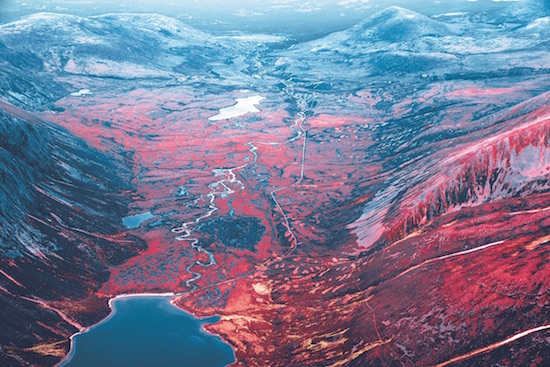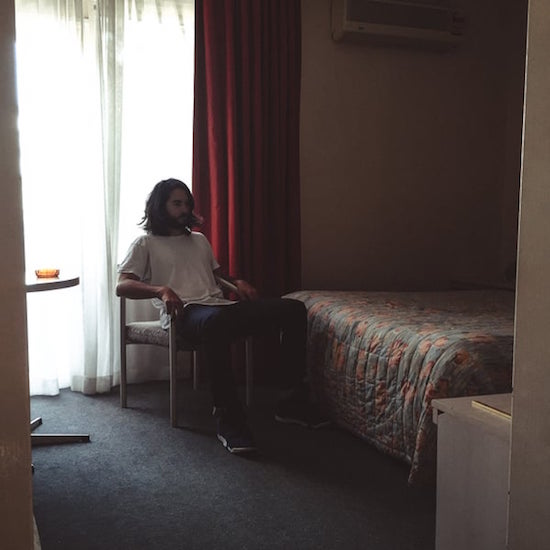Director and photographer Dave Ma, responsible for music videos by the likes of Foals and Forest Swords, has teamed up with Ballantine’s for their second Artist Series, designing a new visual identity for the company. To take the giant landscape photographs, which can be seen below, Ma went up in a helicopter, shooting the images through the open door. Ma has directed a number of videos for Foals, having developed a long-standing relationship with the band, while he has also worked alongside A$AP Rocky, Nick Cave and many more on artwork and videos.
"I was ultimately drawn to working with Ballantine’s for the excitement of doing something completely different, that would still represent my artistic style," Ma says of this new collaboration. "It was awe-inspring to see that part of Scotland, and to be able to shoot a really unique perspective of that landscape. My focus was to capture the natural beauty of the terrain, but I wanted to move the images away from the all-too-familiar green landscapes of the Scottish Highlands and give each gift pack its distinctive look, which reflected the personalities of each of the blends."
With the launch of the video above and the new collaboration, we caught up with Dave Ma recently to talk about his past work, including his beginnings and whether he has any plans for a feature film in the future.
You come very much from a DIY background. How did this influence your film making? What have your DIY roots taught you about making big budget music videos and commercials?
Dave Ma: I don’t think I ever stopped working in that way. Even on projects where there are a lot more people around or you have a lot more resources, I still work the same way, very hands on and very practically. From DIY you learn that almost any problem can be solved without money by just thinking through the problem or rewriting your approach. With DIY you learn out of necessity. With DIY you also learn to appreciate collaborating with other people and it becomes a wider thing than just yourself.
I’ve seen a commercial you did for Replay. It shows these model hippie types in the forest wearing only jeans. They get assaulted by police forces, in full riot gear. Next these jeans, supposedly being bearers of some kind of rebellious spirit, it’s also quite a powerful illustration of the tension between freedom and control. Can this also be understood in the context of your above statements about creative freedom, about DIY?
DM: The idea for that project was ego warriors fighting against riot police. You picked up on that emotion there, that I still connect to. I grew up into an underground scene rejecting mainstream ideas and I still wrestle with aspects of what I do sometimes. I’ve always loved transgressive characters that exist in their own worlds or on the outside of normal day-to-day society. That’s maybe what you’re picking up on there. But it’s also in the music videos, showing kids making their own little weird playground in the forest or someone outside in a vast landscape away from the world, or two girls driving around LA at night. These people exist on a plain outside of the average day-to-day… even if they are in the middle of the city. You know, I’ve always loved that feeling of being in a big city but feeling a little bit separate from it.
I also watched a short film you did about the people living in this little town in the Californian desert by a dried out lake. The voiceover is done by a person who has spent more or less his entire life, working and raising a family, in this place that would strike many people as extremely desolate. What’s the story behind that?
DM: At that time I was really interested in presenting a juxtaposition between the end of a process and something at the beginning of a process. The idea was to interview older people in that town about how they came there and the life they had lived there and then to juxtapose that with teenagers who were in that town at the beginning of their own version of that journey. And I’ve always been pretty obsessed with that time in life, the teenage years, the young adult years. When there’s infinite possibilities and through these you kind of come to define your own identity.
I was actually interviewing a lot of old people in that town and the guy I ended up meeting who did that voiceover just had that perfectly tied together story and it was emotional as well. Quite touching actually, having him share that with me. I didn’t need much more than his real voice. It was a real nice place to be actually. Again, I like this idea of communities existing outside, living in their own little worlds. Worlds within worlds, it’s something I quite like.
You work exclusively outside, am I right? You don’t use the studio.
DM: Yeah, I hate the studio [laughs]. I like natural life. I like the real world. I like the challenge of having to find actual places and transforming them into their own things. I also like the flexibility that you find sometimes, that you can discover something yourself as you’re going along. It’s very experiential. Also from a practical standpoint. You can be shooting one directionals and some little light changes and you move around and there’s an actual environment that’s changing around you. It has its problems that can really sort of mess that up. There’s something nice about embracing the randomness. Like in the city, you scout a place and think it’s going to look good and then you come back and it’s totally different because it’s all been cleaned up. It doesn’t look decrepit anymore. You know, I’ve gone to houses in LA and you go back and they’ve cleaned the whole house, and I’m like, ‘no!’ I didn’t want that because it looked messed up.

Talking of decrepit places, you shot the video for Delphic’s ‘This Momentary’ in the ghost town of Pripyat, which is close to Chernobyl. That’s a very unusual environment. Because nature is creeping back in. How did that come about?
DM: I’ve always loved images of urban decay. Like what we’ve just talked about. I like images of nature but I also like images of the edges of towns and so on. But that specifically came about after reading an article about people moving back into the zone to live in the villages where they grew up, so I became interested in these images of urban decay. A place like Chernobyl, if you say that to anyone they would associate that with something very negative, but reading this article about people moving back in there got me interested in whether there’s actually something going on down there. I just wanted to go that part of the world, to the deserted city of Pripyat and then find these villages where the people returned to. Then go to the edge of the zone where you find the new settlements that have popped up since the disaster, where you do have this wonder of life, humanity existing. That’s why we went there in summer and not winter because many times you see documentaries about Chernobyl, they always go in winter when it’s snowing. But we went there when it was green and lush. You saw nature reclaiming a part of the world. Again, it’s the idea of people living in this odd world that you would not associate with your daily life.
There’s now the possibility of doing guided tours of the zone, you know, as a kind of post-apocalyptic theme park. Obviously many people think it’s a very cynical thing to do. But I think it fits very well into a general interest, at least a voyeuristic impulse, to tap into these end of the world scenarios. I’m also thinking about zombie films. But you’ve been telling a very different story of ‘the zone’. The common conception being extremely negative, it’s a dead place. But people seem to be drawn to it in a perverse way.
DM: I think for better or worse it’s a very human thing to do. Humans have always been stopping and staring. You can say that it’s cynical and voyeuristic but it’s also a natural part of being human. You want to look at something that is so far removed from your own daily existence. I can kind of understand people’s interest in wanting to go there. I don’t really know much about the tourism aspect, whether it’s a positive or a negative thing. But, you know, some people want to go to a perfect beach under a palm tree and some people want to experience another side of humanity that is just really different to your own. There are different ways to travel and there are so many places in the world to go. I can kind of understand people getting tired of the picture postcard perfect holidays and wanting to do something really different.
Humans will always commercialise anything, so suddenly there are tourists going. It’s not that surprising really, when you think about it. But for me it was different. It’s part of a lot of things that I get to do, like to genuinely get interested in a place for the usual metaphorical reasons and then learn about it. I always love going somewhere and just experiencing it while working. You get to see the different sides than if I’d just gone as a tourist or something. You get to see a real side or you get to connect with people that actually live there and have them show you their world a little bit. I find that much more rewarding than going and staying in a hotel or a beach, or shopping at the tourist spots, like anyone. I’m sure you’re the same. You enjoy the more real experiences you have in life.

Jumping to something else completely. How does being a music fan come to influence working with musicians for their music videos? What makes music videos important to you?
DM: Music was my first love. Like a lot of kids, you reach for the things that are around you, that you can discover at an age where you’re forming your own identity. Music fulfills that for a lot of people in a really powerful way. In the nineties you could copy a tape, share it with a friend. Today you can do that too. So for me, it was just the natural thing to get into. Music videos would continue this thing, being immersed in stories and characters.
I think music videos are a natural expression of a band’s identity, at least they should be. That’s a part of every music video, whether it’s the video trying to express something about their song or it’s to juxtapose it in a certain way to make it interesting. The role of music videos has changed a lot in the last twenty years. In the nineties music videos were much more performance based, because they were one of the few ways that people around the world could see their band performing a song or what they looked like. Their identity is visually encrypted in music videos and press shots.
Now with a million YouTube videos of bands playing live or doing radio sessions and 500 phones filming at a live show, you don’t really need to focus on that side of a band as much. Unless you’re an incredible performer like Beyoncé, where you want to be watching that person. But I think now there’s a lot more room for music videos to explore a cinematic idea, a visual idea fits in with that band’s identity. To the point where music videos almost become like a narrative-driven short film. It enables musicians to express their identity in other ways. Of course it also bring back the idea of the complete work of art.
Talking of developing narratives, are you planning any feature films yet?
DM: I would love to make a feature film. Probably most directors work toward that. It’s another beast in itself, a much bigger project. It’s something that’s on my radar, but when that happens I can’t really say. If you look at the work in chronological order, you can see a shift towards expressing a clearer narrative idea. It would be a challenge but also amazing to step it up and have that kind of length of time to really explore, to have 90 minutes to really go into characters. It would be a dream, an amazing thing to tackle. I guess it’s the same kind of thing with writing, you know, when it’s like “1000 words”, or to be able to write a novel. At the same time it’s not something you can just do overnight. You have to work towards it.
Well, can you name a few favourite films then?
DM: Anything that Paul Thomas Anderson does is high on my list, in particular Magnolia, for a lot of the reasons we’ve talked about. I think it’s an incredible, vast portrait of a certain part of humanity. I just love the connecting stories in that film and it’s one that over time I’ve gone back to and got more out of. In a different way there’s a film called Baraka which had a very deep and lasting effect on me when I saw it as a teenager. It’s non-dialogue, just images of the world, but it forms a kind of narrative and comment about the state of societies without the use of fictional set characters. It made me look at filming in a much stronger way. Taxi Driver is a really obvious one, just going to that whole transgressive character thing. But I really obsess about Magnolia, to the point where I actually drive around LA listening to that film. I have a recording of it on my phone and I just like listening to it like an album. Some films are like good albums.
Do you have a dream song to make a music video for?
DM: Nirvana – ‘All Apologies’ or ‘Pennyroyal Tea’, because they never had music videos done for them. Some of the early Nirvana videos really inspired me.


